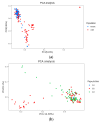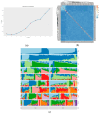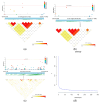Genomic Regions Associated with Growth and Reproduction Traits in Pink-Eyed White Mink
- PMID: 39336733
- PMCID: PMC11431770
- DOI: 10.3390/genes15091142
Genomic Regions Associated with Growth and Reproduction Traits in Pink-Eyed White Mink
Abstract
In mink breeding, balanced selection for growth and reproductive features is essential because these traits are contradictory. The variables of total number born (TNB), number born alive (NBA), and body weight (BW) are highly valuable in terms of their importance in mink production. A comprehensive understanding of the molecular mechanisms that drive these features could offer vital insights into their genetic compositions. In the present study, the single-nucleotide polymorphism (SNP) genotypes of 219 minks were obtained via double digest restriction-site associated DNA sequencing (ddRAD-seq). Following several rounds of screening, about 2,415,121 high-quality SNPs were selected for a genome-wide association study (GWAS). The GWAS was used to determine BW and reproductive traits in pink-eyed white mink. It was suggested that SLC26A36, STXBP5L, and RPS 29 serve as potential genes for the total number of kits born (TNB), while FSCB, PDPN, NKX 2-1, NFKB 1, NFKBIA, and GABBR1 are key genes for the number born alive (NBA). Moreover, RTTN, PRPF31, MACROD1, and KYAT1 are possible BW genes based on association results and available functional data from gene and mammalian phenotype databases. These results offer essential information about the variety of mink and theoretical principles for applying mink breeds.
Keywords: body weight; genome-wide association study; mink; number born alive; single-nucleotide polymorphism; total number born.
Conflict of interest statement
The author declare no conflict of interest.
Figures






Similar articles
-
Survey of SNPs Associated with Total Number Born and Total Number Born Alive in Pig.Genes (Basel). 2020 Apr 30;11(5):491. doi: 10.3390/genes11050491. Genes (Basel). 2020. PMID: 32365801 Free PMC article. Review.
-
Integrative genomic analysis reveals shared loci for reproduction and production traits in Yorkshire pigs.BMC Genomics. 2025 Mar 29;26(1):310. doi: 10.1186/s12864-025-11416-0. BMC Genomics. 2025. PMID: 40158163 Free PMC article.
-
Effect of candidate gene polymorphisms on reproductive traits in a Large White pig population.Anim Sci J. 2016 Dec;87(12):1455-1463. doi: 10.1111/asj.12580. Epub 2016 Mar 28. Anim Sci J. 2016. PMID: 27018129
-
SNP markers associated with body size and pelt length in American mink (Neovison vison).BMC Genet. 2018 Nov 12;19(1):103. doi: 10.1186/s12863-018-0688-6. BMC Genet. 2018. PMID: 30419805 Free PMC article.
-
Genome-wide association study of body weight in Wenshang Barred chicken based on the SLAF-seq technology.J Appl Genet. 2018 Aug;59(3):305-312. doi: 10.1007/s13353-018-0452-7. Epub 2018 Jun 27. J Appl Genet. 2018. PMID: 29946990 Review.
Cited by
-
Comparative Whole-Genome Analysis of Production Traits and Genetic Structure in Baiyu and Chuanzhong Black Goats.Animals (Basel). 2024 Dec 15;14(24):3616. doi: 10.3390/ani14243616. Animals (Basel). 2024. PMID: 39765520 Free PMC article.
References
-
- Nes N., Einarsson E.J., Lohi O., Jorgensen G. Beautiful Fur Animals and Their Colour Genetics. Scientific; Copenhagen, Denmark: 1988.
MeSH terms
Grants and funding
LinkOut - more resources
Full Text Sources

